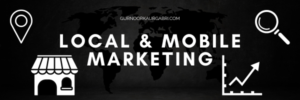
In today’s digital age, reaching your audience effectively is crucial. Local & mobile marketing helps businesses grow faster. Whether you’re a small café or a growing brand, this strategy brings results. It focuses on your nearby audience while using the power of smartphones. Together, these two approaches drive foot traffic and increase sales.
What Is Local & Mobile Marketing?
Local & mobile marketing is a technique to target nearby customers using mobile devices. It uses location-based services, apps, and online platforms. For example, Google Maps ads or SMS alerts to locals are forms of this marketing. Local marketing helps customers find you when they need you the most. Meanwhile, mobile marketing ensures your brand stays in their pocket, literally.
Why It Matters
Firstly, mobile usage is increasing every day. Secondly, people search for nearby places on their phones regularly. According to Google, “near me” searches have grown significantly. That is why businesses must embrace local & mobile marketing.
Furthermore, mobile users tend to act quickly. If someone searches for coffee near them, they often visit within minutes. This behavior presents a golden opportunity. With local SEO and mobile targeting, you can be the first choice.
Key Benefits of Local & Mobile Marketing
- Enhanced Visibility
With mobile optimization, your brand appears in search results on the go. You become easier to find and reach. - Higher Engagement Rates
Mobile campaigns have better click-through and open rates. Additionally, local relevance boosts customer trust and interest. - Real-Time Connection
Push notifications, SMS, and mobile ads work instantly. As a result, you can engage users at the perfect time. - Cost-Effective Strategy
Compared to traditional ads, local & mobile marketing is budget-friendly. Even a low budget can bring high returns. - Personalized Customer Experience
Because of location and mobile data, you can offer custom deals. Personalized marketing builds loyalty and satisfaction.
Mobile Marketing Tools You Should Use
To make the most of mobile marketing, use the right tools. These help automate, analyze, and enhance your campaigns.
- Google Ads (Local Extensions)
It helps show your business location in ads. Also, it attracts users searching nearby. - SMS & MMS Campaigns
These are direct and have higher engagement than email. For example, send offers, reminders, or alerts. - Mobile-Friendly Websites
If your website isn’t mobile-optimized, you’ll lose customers. Therefore, responsive design is essential. - Mobile Apps
A business app increases repeat visits. It also helps build brand loyalty. - Social Media Ads
Platforms like Instagram and Facebook offer precise location targeting. This improves your local & mobile marketing success.
Local Marketing Strategies That Work
This type of marketing is even more effective when combined with offline efforts.
- Google My Business (GMB)
Claim and optimize your GMB profile. Add location, hours, photos, and reviews. This boosts your local visibility. - Location-Based Offers
Offer discounts to nearby users. For instance, “Show this SMS to get 10% off today!” - Collaborate Locally
Partner with other local businesses. Cross-promotions help you reach more customers. - Local Events and Sponsorships
Sponsor or host events. These boost your brand’s image and community presence. - Local SEO
Use location-based keywords on your website. Examples include “best bakery in Brooklyn” or “hair salon near me.”
Challenges in Local & Mobile Marketing
Despite the benefits, this strategy has challenges. However, with the right approach, you can overcome them.
- Data Privacy Rules
Users must give permission to use their location. Ensure compliance with regulations like GDPR. - Device Compatibility
Not all users have the same devices. So, test your site and content across platforms. - Real-Time Updates
You need to update offers and content frequently. If outdated, you risk losing credibility. - Tracking and Analytics
It can be hard to measure results. Use tools like Google Analytics or HubSpot to track user behavior. - Rising Competition
Everyone is going local. To stand out, offer genuine value and quick service.
Tips for Successful Marketing
To conclude, here are some simple yet powerful tips.
- Optimize for voice search like “Where’s the nearest bookstore?”
- Encourage customers to leave online reviews.
- Use short, clear messages in mobile campaigns.
- Keep your content fast-loading and mobile-first.
- Send offers during peak hours for better response.
- Always test your strategy, then tweak as needed.
Future of Local & Mobile Marketing
The future is promising. Technologies like AI, AR, and 5G will boost local & mobile marketing further. Imagine sending personalized ads as someone walks by your store. Or offering real-time discounts based on past visits.
Indeed, the possibilities are endless. But above all, the goal remains the same—connecting with your audience at the right place and time.
Final Thoughts
Local & mobile marketing is no longer optional. It’s a necessity for businesses to thrive in today’s world. By combining the power of location and mobility, you can reach customers more effectively. Whether you own a café, salon, gym, or store, this strategy helps you grow.
Stay updated, stay relevant. And most importantly, stay local and mobile. Because your next loyal customer could be right around the corner.